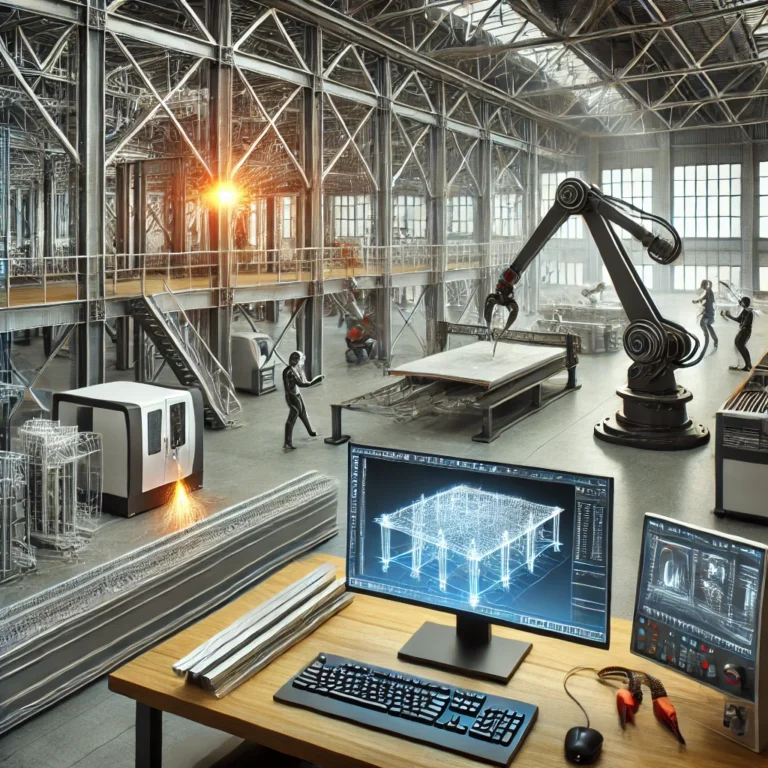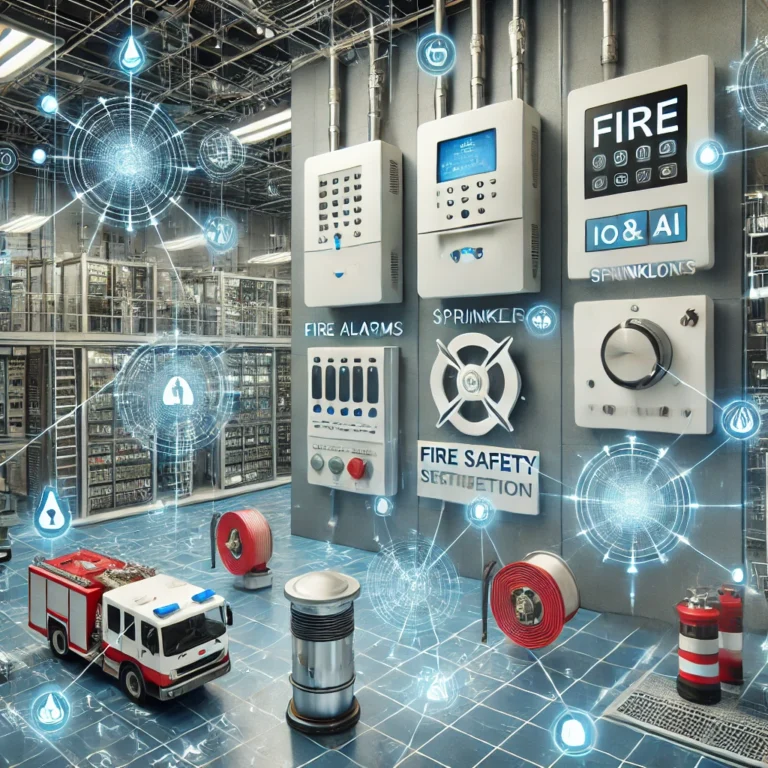Top Trends in Structural Fabrication for 2024
The structural fabrication industry faces significant changes as we approach 2024. New technologies and methods will transform how professionals design, build, and maintain structures. Staying informed about these trends will help stakeholders prepare for the future of structural fabrication. These shifts will improve efficiency, sustainability, and overall project outcomes.
This article reviews the most important trends in structural fabrication for 2024. It explores how automation and robotics are reshaping the fabrication process, discusses advanced fabrication techniques and emerging materials, and highlights sustainable practices gaining traction in the industry. Understanding these trends will position stakeholders for success in the evolving landscape of structural fabrication.

Automation and Robotics in Structural Fabrication
Automation and robotics are elevating structural fabrication to new heights. Companies that adopt these technologies are seeing increased efficiency, precision, and productivity. Key areas impacted include collaborative robots, AI-driven automation systems, and smart sensor-based technologies that integrate with the Internet of Things (IoT).
Collaborative Robots
Collaborative robots, also known as cobots, are revolutionizing structural fabrication. These versatile machines easily integrate into automated processes and offer several advantages:
- Democratization of Automation: Cobots make advanced manufacturing technologies accessible to small and medium-sized businesses due to their affordability and ease of integration.
- High Safety: Cobots come with intuitive programming interfaces and cutting-edge safety features, allowing them to work safely alongside human operators without the need for physical barriers.
- Higher Accuracy: Cobots, equipped with high-resolution vision systems and advanced grippers, handle tasks with extreme precision, detecting even the smallest defects at 99.9% accuracy—far beyond human capability.
- Flexibility and Adaptability: Cobots are lightweight and mobile, making it easy to relocate them across manufacturing environments. This flexibility allows a single unit to perform various tasks across different applications.
- Collaborative Innovation: By fostering close collaboration between humans and robots, cobots create an environment that encourages innovative solutions and process efficiency.
AI-Powered Automation Systems
Artificial intelligence is transforming structural fabrication by enhancing the capabilities of automated systems. Some notable improvements include:
- Increased Production Speed: AI-powered robots increase production speed by 35% while maintaining precision and consistency.
- Energy Optimization: AI optimizes energy usage, cutting energy consumption by 20% and reducing operational costs.
- Improved Maintenance: AI systems, like MineMind, simplify complex topics and enable maintenance teams to complete work orders more efficiently.
- Stock Optimization: AI predicts demand and recommends optimal stock management strategies, leading to cost-effective inventory control.
- Automated Quoting and Scheduling: AI advancements allow algorithms to automate quoting, scheduling, and processing orders for complex subassemblies, streamlining operations.
- Low-Code and No-Code Platforms: AI-driven low-code platforms, such as Microsoft Power Apps, are evolving into no-code platforms, empowering users to create custom applications with minimal coding knowledge.
Smart Sensors and IoT Integration
The integration of smart sensors and IoT technologies is boosting efficiency and quality control in structural fabrication. Key benefits include:
- Real-Time Monitoring: Smart sensors embedded in machinery and production lines capture real-time data, providing valuable insights into the manufacturing process.
- Enhanced Quality Control: These sensors monitor critical variables such as temperature, pressure, and chemical composition at every stage, ensuring the final product meets strict quality standards.
- Predictive Maintenance: By analyzing real-time data, smart sensors can predict potential issues before they escalate, reducing the risk of costly breakdowns.
- Data-Driven Decision-Making: With the vast amount of data generated by smart sensors, manufacturers can make more informed decisions and refine their strategies for greater efficiency.
- Improved Visibility and Control: Integrating smart sensors with Enterprise Resource Planning (ERP) software and legacy systems gives manufacturers a clearer view and better control over the entire production process.
|
Aspect |
Impact of Smart Sensors and IoT |
|
Efficiency |
Streamline processes, optimize each stage |
|
Quality Control |
Real-time monitoring of critical variables |
|
Maintenance |
Implement predictive maintenance strategies |
|
Decision Making |
Provide actionable insights from data analysis |
|
System Integration |
Enhance visibility and control over manufacturing |
The convergence of technologies, such as collaborative robots, AI-powered systems, and smart sensors with IoT integration, is enabling a new era in structural fabrication. Integrate these advancements into your operational methods, and manufacturers can simplify operations, drive down costs, and produce better-quality products that meet the evolving demands of the industry.
Advanced Materials and Fabrication Techniques
The structural fabrication industry is entering a new era, driven by the introduction of advanced materials and fabrication methods. These developments enhance performance, durability, and design flexibility.
High-Performance Alloys
These alloys are gaining popularity in industries like aerospace, automotive, oil and gas, and healthcare.
Key types of high-performance alloys include:
- Stainless Steels: Known for durability and resistance to corrosion.
- Nickel and Cobalt Alloys: Offer high-temperature strength and chemical resistance.
- Magnesium Alloys: Lightweight with solid mechanical properties.
- High-Strength Steels: Exceptional in strength and toughness.
- Titanium Alloys: Lightweight, strong, and corrosion-resistant.
Applications of High-Performance Alloys:
- Aerospace: Used for their strength, durability, and corrosion resistance.
- Industrial Machinery and Equipment: Required where high temperature and pressure tolerance are essential.
- Automotive: Applied in engine components and exhaust systems.
- Oil and Gas: Used in drilling and extraction equipment due to their resilience.
Composite Materials
Composite materials combine strength, lightness, and adaptability, making them indispensable across many industries. Their flexibility allows customization to meet specific requirements, offering a unique blend of properties not available in traditional materials.
Key features of composite materials include:
- Design Flexibility: Easily tailored to specific needs.
- Ease of Manufacturing: Simple to produce in various forms.
- Corrosion Resistance: Highly resistant to environmental degradation.
- Long-Lasting: Durable over extended periods.
- Cost-Effective: Offers value for money due to longevity.
Composites are widely used in aerospace and automotive industries. In aerospace, carbon fibers and high-strength organic fibers like Kevlar 49 have replaced older materials like aluminum.
3D Printing and Additive Manufacturing
3D printing and additive manufacturing (AM) are revolutionizing fabrication with their unmatched accuracy and design flexibility. This technology constructs complex structures layer by layer, saving time and materials compared to traditional subtractive methods.
Advantages of 3D printing for structural fabrication include:
- Complex Geometries: Capable of printing intricate shapes.
- Reduced Waste: Minimizes material wastage through recycling and reuse.
- Direct Printing of Metal Parts: Enables rapid prototyping and manufacturing of metal components.
- Advanced Designs: Achieves detailed designs using metal powder bed fusion.
One prominent method is Wire and Arc Additive Manufacturing (WAAM), which uses wire electrodes as the printing material. WAAM can produce large components without size restrictions and boasts deposition rates greater than 5 kg/h. Research by the Institute of Steel Construction and Materials Mechanics in Darmstadt focuses on applying WAAM for printing connecting elements directly onto steel beams, aiming for efficient structures with minimal material use.
These new materials and fabrication techniques promise continued innovation, offering exciting possibilities for design, performance, and sustainability across industries.

Sustainable and Eco-Friendly Fabrication Practices
The structural fabrication industry is rapidly adopting sustainable practices to reduce environmental impact, conserve resources, and ensure long-term sustainability. Key areas of focus include green steel production, energy efficiency, and waste reduction.
Green Steel Production
The steel industry has made significant progress in minimizing its environmental footprint. Since 1990, U.S. steel producers have reduced CO2 emissions by 37% and energy consumption by 32%, positioning the American steel industry as one of the world’s cleanest and most energy-efficient. Key contributors to green steel production include:
- High Recycling Rates: Steel is one of the most recycled materials.
- Natural Gas Usage: Reduces emissions compared to traditional methods.
- Electric Arc Furnace Technologies: Lowers energy consumption and greenhouse gas emissions by up to 50%.
Energy-Efficient Processes
Energy efficiency is a growing priority for manufacturers, helping reduce costs and lower carbon footprints. Initiatives include:
- Energy Audits: Identify performance deviations and areas for improvement.
- Optimizing HVAC Systems: Efficient climate control reduces energy use.
- LED Lighting: Reduces electricity consumption in factories.
- Energy-Efficient Equipment: Ensures reduced operational costs.
- Advanced Energy Management Systems: Monitor and control energy use.
- Compressed Air System Optimization: Reduces energy waste in high-energy processes.
By adopting these energy-efficient practices, manufacturers can reduce both operational costs and environmental impact.
Waste Reduction and Recycling
Waste reduction and recycling have become central to the structural fabrication industry’s sustainability efforts. Steel, being 100% recyclable, plays a significant role. Key achievements in waste reduction include:
- 60-80 Million Tons of Steel Recycled Annually in North America.
- 14+ Million Tons of Steel Recycled from End-of-Life Vehicles annually in the U.S.
- Effective Waste Management in steel fabrication processes.
- Reuse of Fabrication Scraps: Reduces material waste.
The industry’s dedication to waste reduction extends beyond production. In automotive manufacturing, high-strength steel reduces vehicle weight and lowers total life-cycle CO2 emissions. Steel also plays a critical role in renewable energy systems, such as wind turbines, further contributing to sustainability efforts.
|
Aspect |
Impact |
|
CO2 Emissions Reduction |
37% since 1990 |
|
Energy Intensity Reduction |
32% since 1990 |
|
Annual Steel Recycling |
60-80 million tons |
|
Vehicle Steel Recycling |
14+ million tons annually |
|
Water Reuse in Fabrication |
90% cleaned and returned to the source |
The industry’s commitment to sustainability does not stop at the production processes. Advanced high-strength steel in automotive manufacturing reduces the structural weight of vehicles and lowers total life-cycle CO2 emissions. Steel is also essential in renewable energy systems such as wind turbines, where it plays a critical role in modern, sustainable construction. Steel’s Role in Renewable Energy is increasingly significant as the world shifts to greener technologies.
This shift has attracted huge investments from both public and private stakeholders, enabling steelmakers to explore commercially viable technologies and reliable sources of clean energy.
Moreover, a growing focus on sustainability has also attracted more capital from banks and lenders. Financial institutions are increasingly supporting companies that adopt lower-emission steel production methodologies. Ensuring adherence to sustainable production practices also boosts financial credibility in the market.
Conclusion
It’s an exciting time for the structural fabrication sector, which is undergoing a sea change. Next-generation technologies and greater emphasis on sustainability are reshaping the industry. The integration of automation, robotics, and artificial intelligence (AI) is driving efficiency and precision across every process. Learn more about the impact of these technological advancements in manufacturing.
In parallel, new materials and innovative fabrication techniques, such as high-performance alloys and 3D printing, are opening doors to new design possibilities and higher performance standards. . For a closer look at how 3D printing is revolutionizing fabrication, visit this resource.
The future of the industry will also be shaped by the shift towards greener practices. Green steel production, energy-efficient processes, and initiatives in waste reduction all contribute to lowering the ecological footprint of structural fabrication. These efforts not only benefit the planet but also reduce costs, making companies more competitive. Explore more about eco-friendly fabrication techniques.
Staying ahead in this evolving landscape requires diligence and a commitment to keeping up with these trends. Businesses must continuously adapt to remain competitive in a rapidly changing world.
